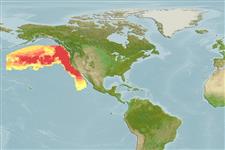Classification / Names
Common names from other countries
Main reference
Size / Weight / Age
Max length : 12.0 cm SL male/unsexed; (Ref. 36121)
Environment
Marine; bathypelagic; depth range 20 - 1095 m (Ref. 6885)
Climate / Range
Deep-water, preferred ?; 54°N - 18°N, 135°E - 111°W
Distribution
Northeast Pacific: British Columbia, Canada to Baja California, Mexico. Bekker (1983) reported a distribution from off Central and South America but this is an error (Ref. 36121). Larvae collected from Taiwan Strait (Ref. 43570).
Countries | FAO areas | Ecosystems | Occurrences | Introductions
Short description
Dorsal
spines
(total): 0;
Dorsal
soft rays
(total): 14-16;
Anal
spines: 0;
Anal
soft rays: 18 - 19;
Vertebrae: 36 - 38. 15-16 AO photophores; 7-8 tooth patches on lower limb of second gill arch; 35-38 lateral line organs (Ref. 36121). Pectoral fins well developed with rather robust, stout rays (Ref. 36121). Nearly black to metallic blue dorsally, lighter on sides, black in mouth and gill cavity; fins dusky, marked with fine wavy lines (Ref. 6885).
IUCN Red List Status (Ref. 115185)
Threat to humans
Harmless
Human uses
Tools
Special reports
Download XML
Internet sources
Estimates of some properties based on models
Phylogenetic diversity index
PD50 = 0.5000 many relatives (e.g. carps) 0.5 - 2.0 few relatives (e.g. lungfishes)
Trophic Level
3.4 ±0.45 se; Based on food items.
Resilience
Medium, minimum population doubling time 1.4 - 4.4 years (Preliminary K or Fecundity.)
Vulnerability
Low to moderate vulnerability (31 of 100)
Price category
